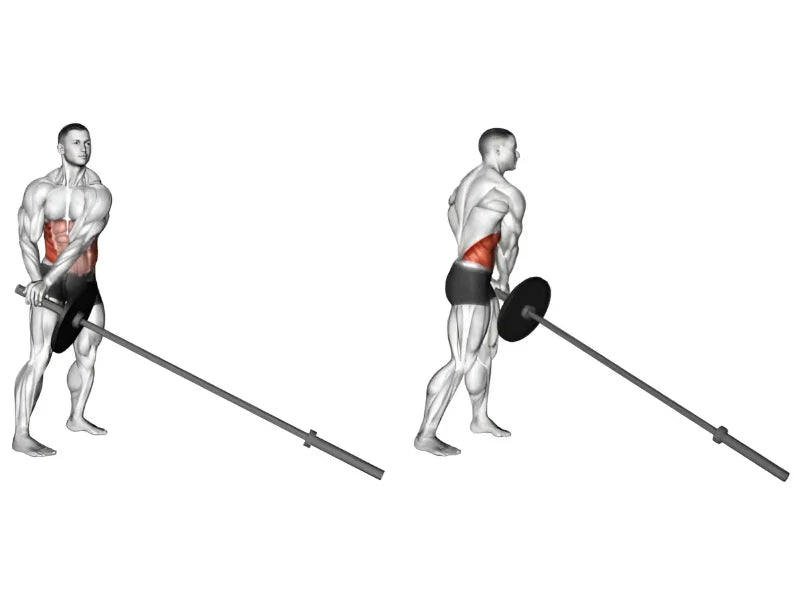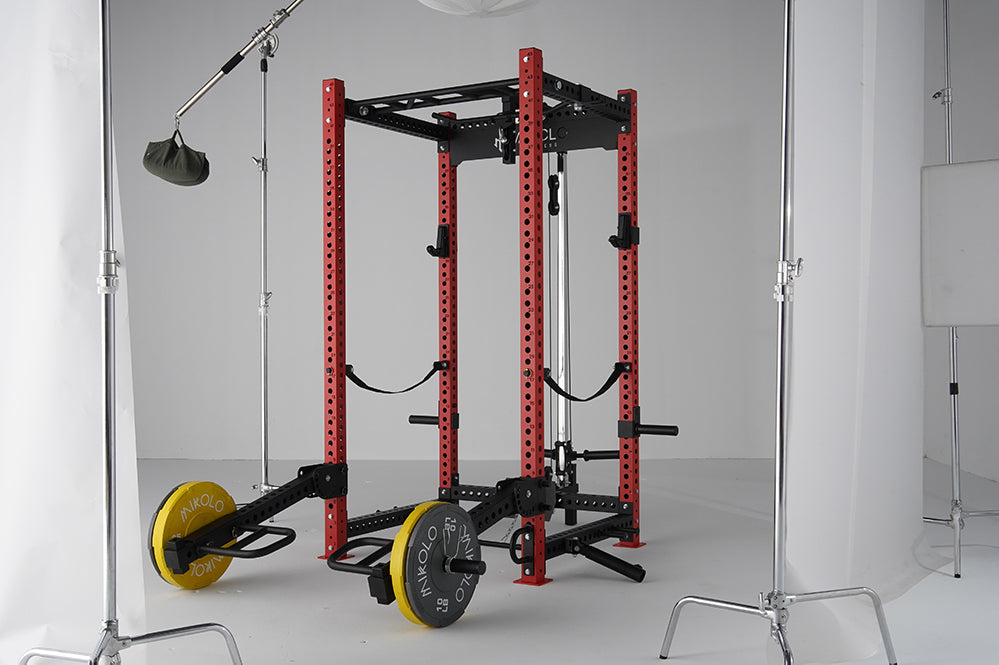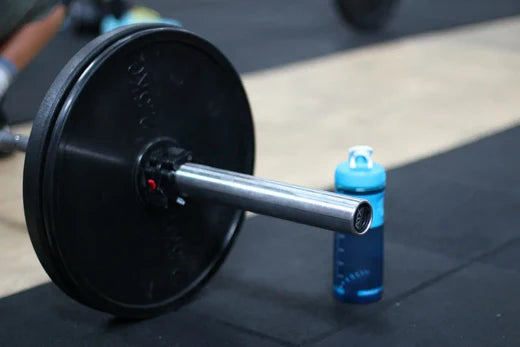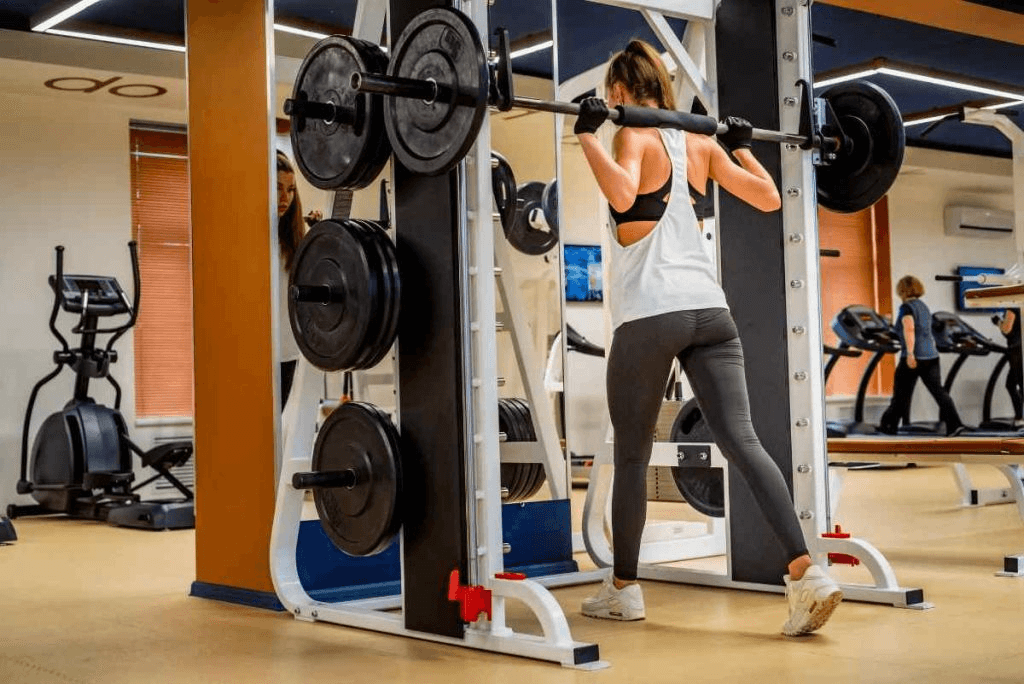Ever wondered about that unusual equipment with a side slot on your squat rack?
Meet the landmine. But don’t fret—it's completely safe. In a gym environment, a landmine is a versatile tool that rotates a full 360 degrees. By inserting a barbell into it and adding weight plates to the opposite end, you can perform a variety of exercises. You might have tried a landmine exercise or two, but did you know it can facilitate a comprehensive full-body workout? Absolutely—and here’s how!
If you’re unfamiliar with using a landmine, don’t worry. I’ll guide you through the proper setup and provide detailed instructions for the best landmine exercises. Plus, if you lack a landmine base at home or at the gym, I’ll share some alternatives to replicate its functionality.
How to Set Up and Use a Landmine
Whether you’re new to landmine exercises or have some experience, setting up your landmine correctly is essential for a safe and effective workout. Start by obtaining a landmine attachment, which can either be a free-standing base or one that attaches to your power rack. While it’s possible to create a makeshift landmine without an attachment, using a proper base is more convenient and secure. Next, insert a standard Olympic barbell into the landmine’s slot. There’s no need for a specialized bar—your regular barbell will work just fine. After positioning the barbell, add weight plates to the free end according to the exercise you plan to perform. For certain exercises, incorporating a handle can provide a better grip and enhance control, although it’s optional for most movements. Once these steps are completed, your landmine is ready for action, setting the stage for a versatile and comprehensive workout.
Top 10 Landmine Exercises to Try
With your landmine set up, you can explore a variety of exercises that target different muscle groups and enhance overall strength and stability.
Landmine Squat is an excellent exercise that targets the quadriceps, hamstrings, glutes, and core. It’s particularly suitable for beginners because the weight is positioned in front of the body, promoting an upright posture and reducing the risk of injury. To perform a landmine squat, load the barbell with your chosen weight and stand close to the plates with your feet shoulder-width apart, facing the landmine. Grip the barbell and lift it to chest height, engage your core and glutes, then squat down until your thighs are at least parallel to the ground. Pause briefly before pushing through your heels to return to the starting position, and repeat for the desired number of repetitions.
Meadows Row enhances the upper back, lats, and biceps through a unilateral movement that helps correct muscle imbalances and boosts grip strength. To execute this exercise, stand sideways to the bar with one foot back in a split stance. Bend at the waist and grab the bar with an overhand grip, stabilizing yourself with your free arm placed on your thigh. Row the barbell upward while maintaining a neutral spine, squeeze at the top, and then slowly lower the barbell back down. Complete the reps on one side before switching to the other arm.
Rotational Single-Arm Press works the deltoids and improves overhead press technique while enhancing core stability during movement transitions. Begin by facing the landmine and adding weight to the bar. Squat to grip the barbell and stand upright, starting with one hand while placing the opposite hand near your shoulder for stability. Engage your core, perform a slight squat, and press the barbell across your body, rotating your torso. Return to the starting position and perform reps on one side before switching to the other arm.
Landmine Rotation, also known as Landmine Rainbows or 180s, targets the core muscles, including the obliques and lower back. This exercise mimics functional rotational movements used in daily activities. Stand near the end of the barbell, facing the landmine base, and grip the bar with both hands. Lift it to chest height and rotate your torso to move the barbell down to one side, then return to center and rotate to the opposite side. Continue alternating sides for the desired number of repetitions.
Half-Kneeling Landmine Shoulder Press engages the shoulders, chest, lats, triceps, and core. Pressing at an angle reduces joint strain, making it suitable for those with shoulder limitations. Assume a half-kneeling position with one leg forward and grip the barbell near your shoulder. Engage your core and press the bar upward at a slight angle before lowering it back to the starting position. Complete reps on one side before switching legs and arms.
Landmine Lateral Raise targets all three heads of the deltoids with a greater range of motion, promoting muscle hypertrophy. Stand sideways to the bar and grip it with one hand, positioning the bar near your hip with your arm straight. Raise the barbell diagonally across your body to shoulder height, then lower it back to the starting position. Perform reps on one side before switching to the other arm.
Landmine Row, also known as the T-bar row, strengthens the lats, upper back, rear delts, and biceps, allowing for heavier lifting compared to traditional barbell rows. Load the barbell with weight plates and stand facing away from the landmine with a wide stance. Lean forward and grip the bar with a neutral or V-handle, pull the bar toward your lower chest while squeezing your back muscles, and slowly extend your arms back to the starting position. Repeat for the desired number of repetitions.
Landmine Reverse Lunge engages the quads, hamstrings, glutes, and core while improving balance and stability. Stand facing the landmine base and grip the barbell at chest height. Step backward with one leg into a lunge position, lowering your body until the front knee is bent at 90 degrees. Push through the front heel to return to the starting position and alternate legs for each rep.
Landmine Romanian Deadlift focuses on the hamstrings, glutes, core, and lower back. To perform this exercise, load the barbell with weights and stand facing the base. Grip the barbell near your pelvic area, maintain a slight knee bend, and hinge at the hips to lower the bar toward the floor while keeping your back straight. Engage your hamstrings and glutes to return to the standing position. For added challenge, you can switch to a single-leg variation to further enhance glute and hamstring activation.
Landmine Press targets the chest, deltoids, and triceps, with the angled press path reducing shoulder joint stress. Load the barbell and position yourself at the end, gripping the bar with both hands and lifting it to chest height. Engage your core and press the bar upward and slightly forward until your arms are fully extended, then slowly lower the bar back to the starting position. Repeat for the desired number of repetitions.
Landmine Single-Arm Floor Press builds muscle in the chest, triceps, and deltoids while helping to correct muscular imbalances and improve performance in compound lifts like the bench press. Lie on the floor near the barbell with your feet flat and knees bent. Position the bar near your shoulder, grip it with both hands, lift it off the floor, and then release one hand. Lower the barbell with the working arm until your shoulder and triceps touch the floor, then press the bar back up, mimicking a single-arm dumbbell press. Perform reps on one side before switching to the other arm.
Advantages of Landmine Exercises
Incorporating landmine exercises into your workout routine offers several key benefits. Firstly, these exercises are joint-friendly due to the unique bar path of landmine presses and squats, which reduces strain on the joints and makes them suitable for individuals with joint concerns. Additionally, landmine exercises add variety to your workouts, preventing monotony and promoting comprehensive muscle engagement by allowing you to perform movements while standing, kneeling, or lying down. Another significant advantage is the enhancement of grip strength; holding the bar’s sleeve, which is typically thicker, improves grip strength, benefiting other lifting exercises.
Landmine Alternatives
If you don’t have access to a landmine setup, there are ways to mimic landmine exercises. One method involves using a dumbbell and a weight plate by placing one end of the barbell on top of a weight plate and stacking a heavy dumbbell on top. This setup allows the barbell to pivot while preventing excessive movement, enabling you to add weights to the other end as usual. Another alternative is placing the barbell in the corner of a room to act as a pivot point. However, this method can potentially damage walls over time, so it’s advisable to protect your walls if you choose this option. While these alternatives can work, investing in a proper landmine attachment is recommended for frequent use to ensure safety and functionality.
Final Thoughts on Landmine Exercises
Incorporating landmine exercises into your workout routine can add much-needed variety, enhance grip strength, and offer joint-friendly movements that support overall fitness. To maximize the benefits and ensure safety, always begin with a proper warm-up that includes cardio, dynamic stretches, and lighter sets of your chosen exercises. Start with lighter weights to familiarize yourself with landmine movements before progressing to heavier loads. Maintaining a tight core throughout all landmine exercises is crucial for stability and spine protection. Whether you’re a beginner or an experienced lifter, landmine training can add a valuable dimension to your fitness journey, promoting improved strength, balance, and muscle development.
Landmine Exercises: Frequently Asked Questions
Are landmine exercises effective for a good workout?
Absolutely. Landmine exercises facilitate full-body activation and can be performed in various stances—standing, kneeling, or lying down—providing a comprehensive workout that targets multiple muscle groups.
Which muscles do landmine exercises target?
Different landmine exercises focus on different muscle groups. For the lower body, exercises like landmine squats, reverse lunges, and Romanian deadlifts target the quads, hamstrings, and glutes. Upper body exercises such as the Meadows row, lateral raise, and press work the back, shoulders, and arms. Additionally, rotational movements engage the abdominal and lower back muscles, providing a well-rounded workout.
What are the benefits of the landmine row?
The landmine row, or T-bar row, primarily targets the upper back, lats, rear delts, and biceps. Compared to traditional barbell rows, it allows for heavier lifting and offers versatility in grip options, which enhances upper back development. This exercise is safe, easy to learn, and effective in building upper body strength.
Incorporate these 11 landmine exercises into your workout routine to experience improved strength, balance, and muscle development. Whether you’re a beginner or an experienced lifter, landmine training can add a valuable dimension to your fitness journey.














































Leave a comment
This site is protected by hCaptcha and the hCaptcha Privacy Policy and Terms of Service apply.